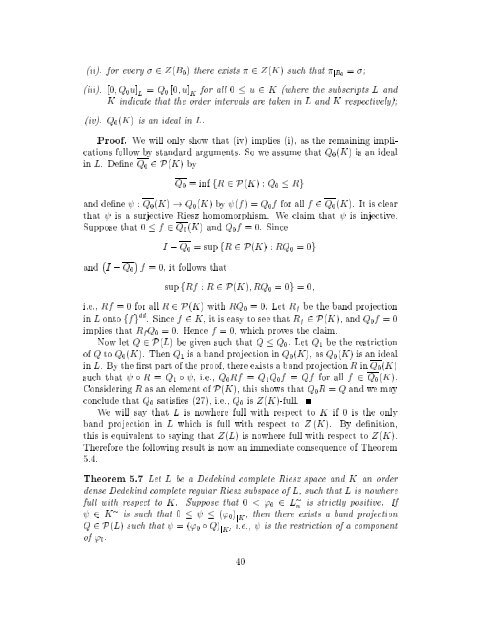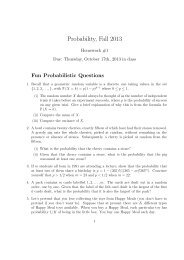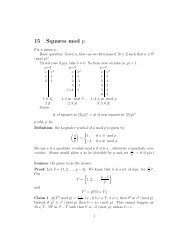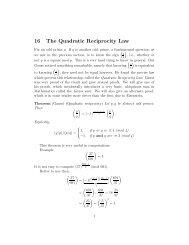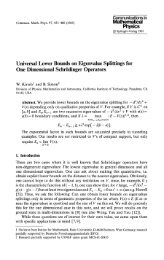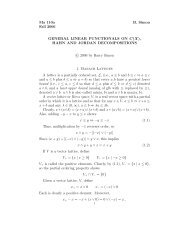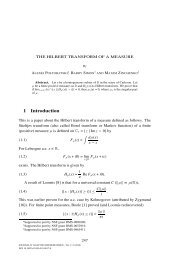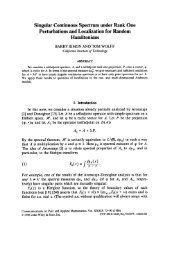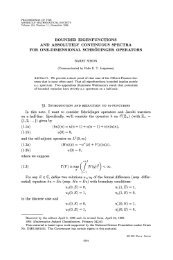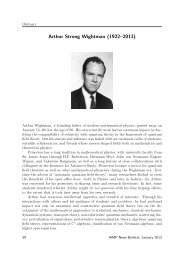Representations of positive projections 1 Introduction - Mathematics ...
Representations of positive projections 1 Introduction - Mathematics ...
Representations of positive projections 1 Introduction - Mathematics ...
You also want an ePaper? Increase the reach of your titles
YUMPU automatically turns print PDFs into web optimized ePapers that Google loves.
(ii). for every 2 Z(B 0) there exists 2 Z(K) such that jB0 = <br />
(iii). [0Q 0u] L = Q 0 [0u] K for all 0 u 2 K (where the subscripts L and<br />
K indicate that the order intervals are taken in L and K respectively)<br />
(iv). Q 0(K) is an ideal in L.<br />
Pro<strong>of</strong>. We will only show that (iv) implies (i), as the remaining implications<br />
follow by standard arguments. So we assume that Q 0(K) isan ideal<br />
in L. De ne Q 0 2P(K) by<br />
Q 0 =inffR 2P(K) :Q 0<br />
and de ne : Q 0(K) ! Q 0(K) by (f) =Q 0f for all f 2 Q 0(K). It is clear<br />
that is a surjective Riesz homomorphism. We claim that is injective.<br />
Suppose that 0 f 2 Q 0(K) and Q 0f =0. Since<br />
and ; I ; Q 0 f =0,it follows that<br />
Rg<br />
I ; Q 0 =supfR 2P(K) :RQ 0 =0g<br />
sup fRf : R 2P(K)RQ 0 =0g =0<br />
i.e., Rf = 0 for all R 2P(K) withRQ 0 =0. Let Rf be the band projection<br />
in L onto ffg dd . Since f 2 K, it is easy to see that Rf 2P(K), and Q 0f =0<br />
implies that RfQ 0 =0. Hence f =0,which proves the claim.<br />
Now let Q 2P(L) be given such that Q Q 0. Let Q 1 be the restriction<br />
<strong>of</strong> Q to Q 0(K). Then Q 1 is a band projection in Q 0(K), as Q 0(K) isanideal<br />
in L. By the rst part <strong>of</strong> the pro<strong>of</strong>, there exists a band projection R in Q 0(K)<br />
such that R = Q 1 , i.e., Q 0Rf = Q 1Q 0f = Qf for all f 2 Q 0(K).<br />
Considering R as an element <strong>of</strong>P(K), this shows that Q 0R = Q and we may<br />
conclude that Q 0 satis es (27), i.e., Q 0 is Z(K)-full.<br />
We will say that L is nowhere full with respect to K if 0 is the only<br />
band projection in L which is full with respect to Z (K). By de nition,<br />
this is equivalent to saying that Z(L) is nowhere full with respect to Z(K).<br />
Therefore the following result is now an immediate consequence <strong>of</strong> Theorem<br />
5.4.<br />
Theorem 5.7 Let L be a Dedekind complete Riesz space and K an order<br />
dense Dedekind complete regular Riesz subspace <strong>of</strong>L, such that L is nowhere<br />
full with respect to K. Suppose that 0 < '0 2 Ls n is strictly <strong>positive</strong>. If<br />
2 Ks is such that 0 ('0) jK , then there exists a band projection<br />
Q 2P(L) such that =('0 Q) jK , i.e., is the restriction <strong>of</strong> acomponent<br />
<strong>of</strong> '0. 40


